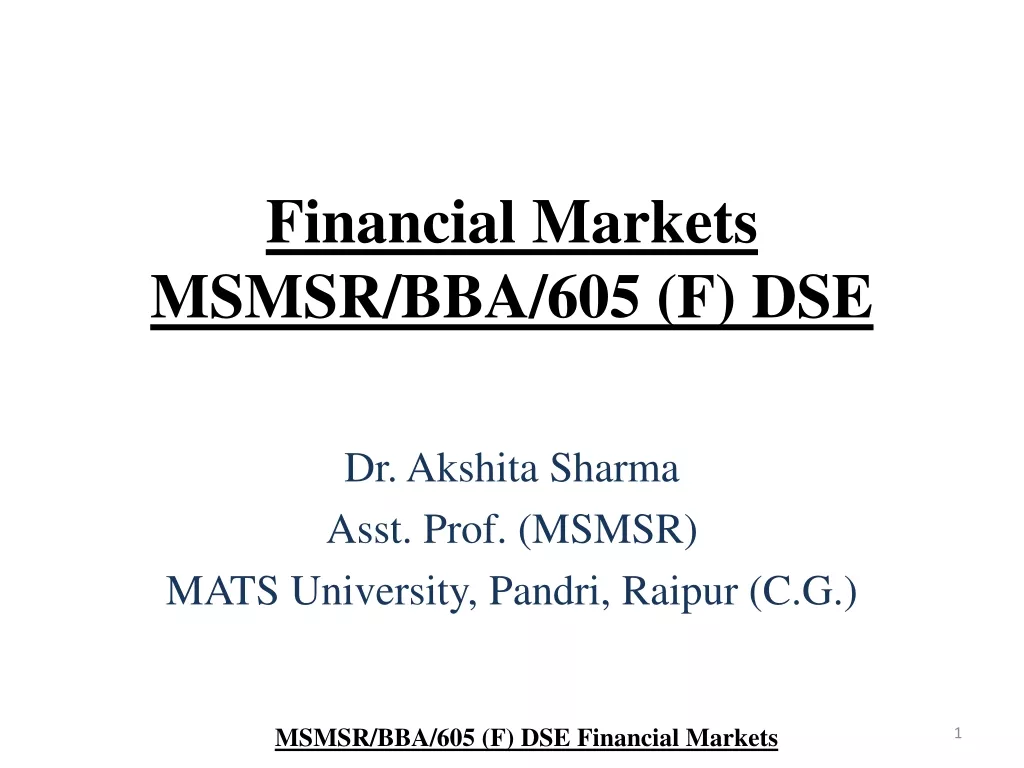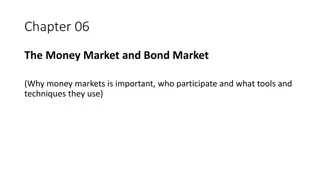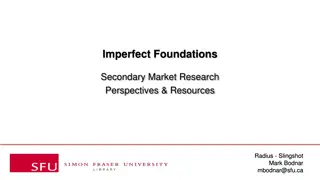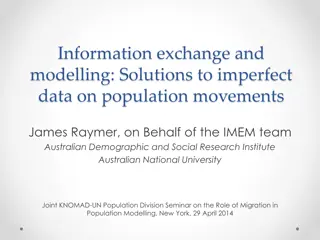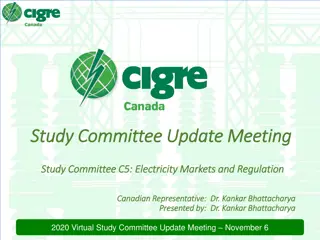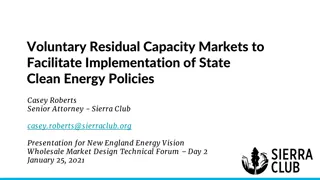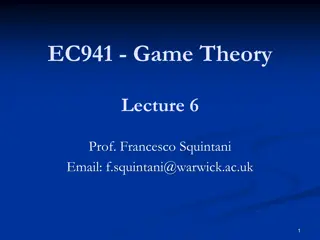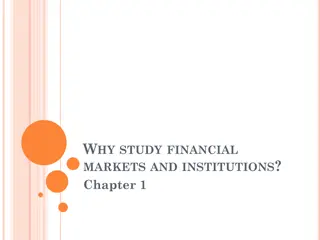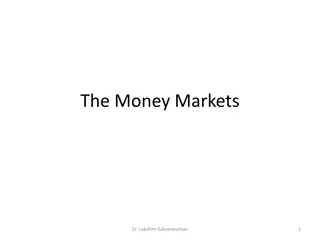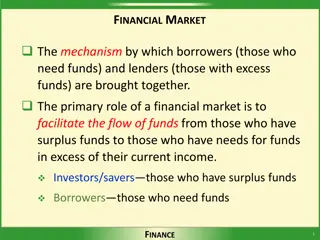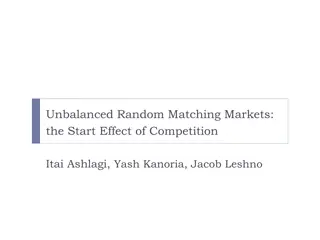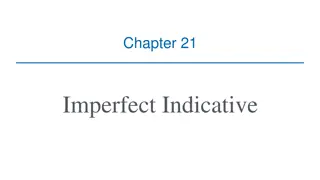Efficiency and Imperfect Markets Overview
Efficiency and Imperfect Markets delve into the concept of Pareto optimality, defining how a situation is considered Pareto optimal and the conditions for a Pareto improvement. The content explores various scenarios and actions to determine if they lead to Pareto improvements and discusses efficiency in a pure exchange economy using the Edgeworth box model. Lessons on Pareto optimality emphasize maximizing well-being across different initial allocations of goods and the importance of ethical considerations in public policy analysis.
Download Presentation

Please find below an Image/Link to download the presentation.
The content on the website is provided AS IS for your information and personal use only. It may not be sold, licensed, or shared on other websites without obtaining consent from the author.If you encounter any issues during the download, it is possible that the publisher has removed the file from their server.
You are allowed to download the files provided on this website for personal or commercial use, subject to the condition that they are used lawfully. All files are the property of their respective owners.
The content on the website is provided AS IS for your information and personal use only. It may not be sold, licensed, or shared on other websites without obtaining consent from the author.
E N D
Presentation Transcript
Chapter 4: Efficiency and Imperfect Markets We want the spirit of America to be efficient; we want American character to be efficient; we want American character to display itself in what I may, perhaps, be allowed to call spiritual efficiency--clear disinterested thinking and fearless action along the right lines of thought. Woodrow Wilson (former President of the U.S.) I don't like a man to be too efficient. He's likely to be not human enough. Author: Felix Frankfurter (former Supreme Court Justice)
Efficiency Concept: Pareto Optimality Definition: Pareto optimality. A situation is Pareto optimal if it is impossible to make any person better off without making at least one person worse off. In other words, Pareto optimality requires that all possible opportunities for efficient production and mutually beneficial trade have been fulfilled. Definition: Pareto improvement. An action leads to a Pareto improvement if it makes at least one person better off without making at least one person worse off. The Two Conditions for a Pareto Improvement: (1) Total benefits must be greater than total costs. (2) Losers (if any) must be fully compensated for their net losses. Relation: If a situation is Pareto optimal, no Pareto improvement is possible.
Your Turn 4-1: Will the following actions produce Pareto improvements? A. Robin Hood robs Prince John to feed his merry men. B. The Sheriff of Nottingham arrests Robin Hood, thereby preventing further theft. C. The U.S. government increases aid to the homeless, paying for the program with a slight increase in the corporate income tax. D. The Salvation Army feeds the hungry with voluntary donations from the well-to-do.
Efficiency in a Pure Exchange Economy: The Edgeworth Box The Edgeworth box model assumes that there are two individuals, who we will label Dottie and Schwartz, and two goods. Each individual starts with fixed quantities of the two goods. These initial quantities represent the endowment point.
Pareto Optimality (P.O.) after Exchange: Any Point of Tangency on the Black Contract Curve is P.O.
Lessons of Pareto optimality Pareto Optimality maximizes the well-being of both parties given any initial distribution of goods. Pareto optimality and Pareto improvement vary with the initial allocation of goods. An allocation of goods that leaves one person with everything and another with nothing will be Pareto optimal since transferring goods from the person with everything will cause him or her to be worse off. Therefore, it is often important to include ethical considerations as well as efficiency when analyzing the social impact of a public policy.
The Kaldor-Hicks Principle Definition: The Kaldor-Hicks Principle (also known as the Fundamental Rule of Policy Analysis) states that a policy should be adopted if the winners could IN PRINCIPLE compensate the losers. This principle requires that the total benefits outweigh the total costs but does not require that the losers actually be compensated. The One Condition for Meeting the Kaldor Hicks Principle: Total benefits must be greater than total costs.
Review: Net Gains from a Private Competitive Equilibrium In a Private Market (with only buyers and sellers), Net Gains equal the sum of Consumer and Producer Surplus (areas A and B in Figure 4-3)
Claim: A Competitive Equilibrium is Pareto optimal This claim has been formally proven mathematically for many years. Note that if the price rises consumer surplus Falls If price falls producer surplus falls If the quantity decreases from 10, one or both of the surpluses must also fall.
Markets May Not Be Perfect There may not be many buyers and sellers. A market with a single seller is called a monopoly. A market with a few sellers is called an oligopoly. A market with one buyer is called a monopsony. Information may be incomplete and unequally distributed. Markets may not be complete, creating what are called externalities. Mobility (entry and exit) may be costly, and other costs of buying and selling may exist.
Demand for A Competitive Firm vs. a Monopoly (A single seller) Figure 4-7: Individual and Market Demands Competitive Market Competitive Firm Monopoly Supply Market Demand = Firm s Demand Price Firm s Demand Market Demand Quantity Quantity Quantity
Monopoly Demand and Marginal Revenue Concepts: total revenue (or total spending) equals price x quantity marginal revenue equals the change in total revenue for each one unit change in quantity. Your Turn: Explain why the marginal revenue of the third unit in Table 4-1 is less than the price of $14. Table 4-1: Monopoly Demand and Marginal Revenue Quantity (Q) Price (P) Total Revenue (P x Q) Marginal Revenue 0 20 0 1 18 18 2 16 32 3 14 42 4 12 10 48 50 48 5 6 8 7 6 42 8 4 32 xx 18 14 10 6 2 -2 -6 -10
Monopoly Profit Maximization Steps for Monopoly Profit Maximization: (1) Find the Quantity where Marginal Revenue = Marginal Cost (Qm in Figure 4-8) (2) Go up to the Demand Curve to find the highest price consumers are willing to pay for that quantity (Pm in Figure 4-8) Effects of Monopoly: (1)Quantity falls and price rises (2)consumer surplus falls (3)producer surplus generally rises (4)Total net gains falls, leaving a deadweight loss
Deadweight Loss Concept: Deadweight Loss equals the lost net gains due to a market inefficiency or government policy. It equals the total net gains under a perfectly competitive equilibrium MINUS the total net gains under any other market situation.
The Efficiency Effects of Monopoly vs. Competition Table 4-2: Market Condition Consumer Surplus Producer Surplus Net Gain Deadweight Loss A+B+C A -B-C D+E B+D B-E A+B+C+D+E A+B+D -C-E None C+E C+E Competition Monopoly Difference
Unequal Information: When consumers receive lower benefits than they expect In Figure 4-10 the consumer thinks she is receiving the value associated with D2, but after buying the product will actually receive the benefits under demand curve D1. Consumer Surplus in Figure 4-10 Market Condition Total Value Total Spending Consumer Surplus (Value-Spending) B+C B-D-E (The dotted areas) B+C+F+G+I+J F+G+I+J B+C+F+G+I+ J+H+K Competition Unequal Information C+D+F+G+I +J+E+H+K The Efficiency Effects of Unequal Information Market Condition Consumer Surplus B+C B-D-E -C-D-E Producer Surplus F+I C+D+F+I C+D Net Gain Deadweight Loss None E E B+C+F+I B+C+F+I-E -E Competition Unequal Information Difference
Externalities: Effects of a market on those not participating in that market Private cost = the cost of production to the firm. This generally does not include external costs to outsiders from pollution or other effects. The usual market supply curve is based on the marginal costs of producers. External cost = the negative effect of production of a good on parties who are not involved with the production or consumption of the good. Positive externalities can be thought of as negative external costs. Social cost = private cost of production to the firm + external cost to others. For goods whose production or consumption leads to external harms, the good s social cost will be higher than its private cost. However, a good which offers external benefits, such as the beekeeper s honey bees or a beautiful building, will have a social cost which is lower than its private cost. Marginal social cost = the change in society s total cost for a given change in output. It also equals marginal private cost + marginal external cost. In this case the two costs are added vertically
Inefficiency in a Market with Negative Externalities external surplus = external benefits - external costs, or the net benefits experienced by persons or firms not directly involved in production of a particular good. Net Gains now include: Consumer Surplus Producer Surplus External Surplus
Efficiency: Private Versus Social Equilibrium Table 4-6: The Efficiency Effects of Negative Externalities Market Condition Consumer Surplus Producer Surplus External Surplus Net Gain Deadweight Loss Private Equilibrium Price Social Equilibrium Price Difference A+B+C+D E+F+G -C-F-H-D-G A+B+E-H H A B+C+E+F -C-F A+B+E None -B-C-D B+C-G H+G+D H H
The Effects of Monopoly by the Numbers: The Competitive Result Demand: P=30-2Q Marginal Revenue: MR=30-4Q Supply or Marginal Cost: P=0+Q Step 1: Find the competitive equilibrium where Demand = Supply 30 2Q = Q Qc=10 Pc = $10 from either demand or supply. Competitive Consumer Surplus = * (30-10)*10 = 100 Competitive Producer Surplus = *10*10 = 50 Net Gains =150
The Monopoly Result Demand: P=30-2Q Marginal Revenue: MR=30-4Q Supply or Marginal Cost: P=0+Q Step 1: Set MR = MC to find the monopoly Quantity 30-4Q = Qm Qm = 6 Step 2: Plug this quantity into the Demand Equation to find the price Pm = 18 Step 3: to find producer surplus, you also need To find the marginal cost at Q=6, MCm=6 Step 4: Find the Surplus and Gains areas Consumer Surplus = *(30-18)*6 = 36 Producer Surplus (trapezoid or rectangle + triangle) = *6*6 + (18-6)* 6 = 90 Net Gains = 36 + 90 = 126 Deadweight Loss = 150 = 126 = 24 (the difference between the competitive and monopoly net gains).
Imperfect Information with numbers True demand (D1): P = 90 - Q Perceived demand: P = 110 - Q Supply: P = 10 + Q. Find the price, quantity, and the dollar values of the consumer and producer surplus and total net gains (CS + PS) in a market with perfect information (use true demand only).
Imperfect Information with numbers The Perfect Information Case True demand (D1): P = 90 - Q Perceived demand: P = 110 - Q Supply: P = 10 + Q. Set True Demand = Supply 90 Q = 10 + Q Q = 40 P = 50 Consumer Surplus = (1/2)($90 - $50)(40) = $800 Producer Surplus = (1/2)($40)(40) = $800 Net Gains = $1600
Imperfect Information with numbers The Consumer is Fooled True demand (D1): P = 90 - Q Perceived demand (D2): P = 110 - Q Supply: P = 10 + Q. Set Perceived Demand = Supply Find new Price and Quantity, Then find the surplus values Hint: Consumer Surplus is not a single triangle
Imperfect Information with numbers The Consumer is Fooled True demand (D1): P = 90 - Q Perceived demand (D2): P = 110 - Q Supply: P = 10 + Q. 110 Q = 10 + Q Q = 50 P = 60 Consumer Surplus = (1/2)($90 - $60)(30) (1/2)($60 $40)(20) = $450 - $200 = $250 Producer Surplus = (1/2)($60 - $10)(50) = $1250 Deadweight Loss = $1600 - $1500 = $100
External Costs with Numbers: Private Equilibrium marginal private cost: MCp = 10 + Q marginal external cost MCx = Q marginal social cost MCs = 10 + 1.5 Q demand: P = 100 - Q
External Costs with Numbers: Private Equilibrium marginal private cost: MCp = 10 + Q marginal social cost MCs = 10 + 1.5 Q demand: P = 100 Q A. private equilibrium price and quantity: 100-Q = 10 + Q 90 = 2Q Q = 45 P = $55 B. Surplus Values: CS = x 45 x ($100-55) = $1,012.5 PS = x 45 x ($55-10) = $1,012.5 Ex. S. = - $506.25. Net Gains = 1012.5 + 1012.5 506.25 = $1,518.75
Social Equilibrium With Externalities marginal private cost: MCp = 10 + Q marginal social cost MCs = 10 + 1.5 Q demand: P = 100 Q To find equilibrium quantity and price, set MCsocial equal to demand. 100 Q = 10 + 1.5 Q 90 = 2.5 Q Q = 36 P = $64 Total Social Surplus is the area between Demand and Social Cost = 36 (100-10) = $1,620.
Public Goods Public goods are goods for which consumption is entirely external to the individual. Those purchasing a purely public good will consume no more of it than a neighbor who pays nothing for the same good. A public good has no rivalry in consumption. This means that a public good can be consumed or enjoyed by more than one person simultaneously. The second characteristic of public goods isnon-excludability. Non-excludability means that one cannot prevent someone from consuming a public good if they have not paid.
Conclusion This chapter discussed general efficiency concepts such as Pareto optimality, the efficiency of a perfectly competitive market, and the effects of market imperfections on market efficiency. All of these general goals were analyzed using net benefits concepts such as producer and consumer surplus. These concepts were then applied to mathematical examples using equations and algebra.


